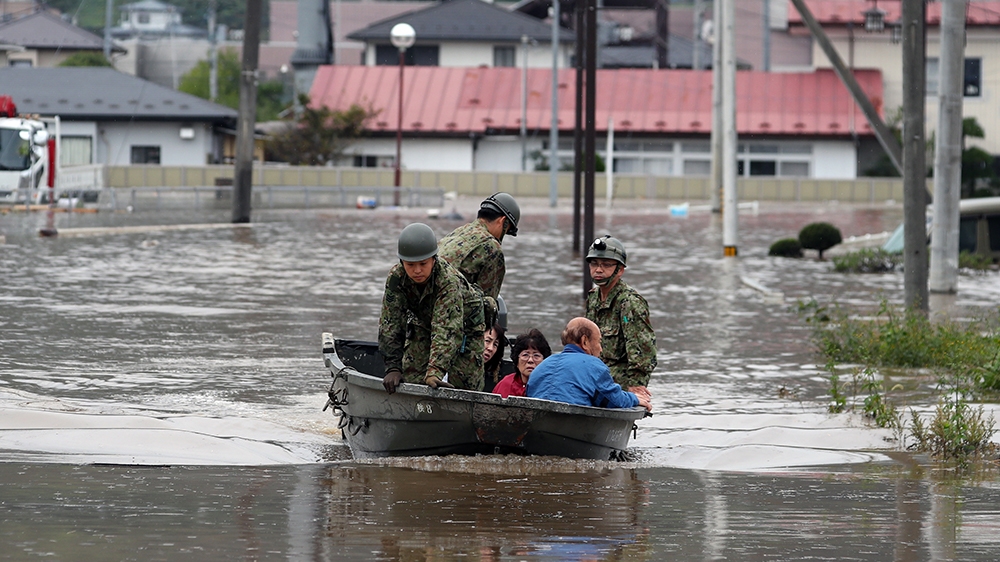Japan begins clean-up after Typhoon Hagibis leaves dozens dead
Rescue efforts under way and power being restored after powerful typhoon swamps Nagano, gateway to the Japanese Alps.

Tens of thousands of troops and rescue workers worked in Japan on Monday to fight floods and help stranded residents after one of the most powerful typhoons to hit the country in six decades left as many as 36 people dead.
Typhoon Hagibis – which means “speed” in the Philippine language, Tagalog – left the capital, Tokyo, relatively unscathed, but caused serious damage to surrounding regions, as rivers burst their banks and the torrential rain triggered landslides.
Keep reading
list of 4 itemsThe Last Shark
Canada wildfires spur evacuation orders, warnings: What you need to know
Evacuation orders issued as wildfire grows near Canada’s Alberta oil patch
More than 100,000 rescuers – including 31,000 troops – clawed their way through debris from Sunday night into Monday morning to reach people trapped by the floods or whose homes had been buried.
Authorities warned more mudslides were possible with more rain forecast.
Kyodo News service, assembling information from a wide network, counted 36 deaths caused by the typhoon with 16 people missing. The official count from the Fire and Disaster Management Agency was 19 dead and 13 missing.
Rivers overflowed their banks at close to a dozen locations — including in Nagano in central Japan, where the Chikuma River breached an embankment and water gushed into residential neighbourhoods, flooding homes up to the second floor.
Mimori Domoto, who works at Nagano craft beer-maker Yoho Brewing, said all 40 employees at her company had been confirmed safe.
But deliveries had temporarily halted, and an event to promote the beer in Tokyo over the weekend had to be cancelled.
“My heart aches when I think of the damage that happened in Nagano. Who would have thought it would get this bad?” she said.
Military and fire department helicopters winched survivors from roofs and balconies in several locations, but in Fukushima one rescue went tragically awry when a woman died after falling from the cradle.
Elsewhere, rescue workers carried out an hours-long boat operation to evacuate hundreds of people from a retirement home in Kawagoe, northwest of Tokyo, which was flooded up to its top floor.
An elderly woman wearing an orange life vest was brought out from a boat on the back of a rescuer. Others were hoisted onto wheelchairs and pushed along a muddy shore on arrival by boat.
Hagibis made landfall on the main Japanese island of Honshu around 7pm (10:00 GMT) on Saturday, with wind gusts of up to 216 kilometres per hour (134 miles per hour). A magnitude 5.7 earthquake shook Tokyo shortly after.

Prime Minister Shinzo Abe convened an emergency meeting of relevant ministers and dispatched the minister in charge of disaster management to the worst-hit areas.
The dead included a municipal worker whose car was overcome by floodwaters and two Chinese crew members aboard a boat that sank overnight in Tokyo Bay.
Four of the crew were rescued, but authorities were still searching for another six.
Abe offered condolences to the families of those who died and said the government was working to save people’s lives and property.
“The government will do everything in its power to cooperate with relevant agencies to restore services as soon as possible,” he said.
Tokyo Electric Power Co said 56,800 homes were still without electricity on Monday in Tokyo and nearby prefectures that the utility serves.
Tohoku Electric Power Co said 5,600 homes were without power in Miyagi, Iwate, Fukushima and Niigata.

‘Ongoing danger’
The typhoon caused a total of 48 landslides in 12 prefectures, the government said.
At the storm’s peak, more than seven million people were placed under non-compulsory evacuation orders.
The storm prompted the Japan Meteorological Agency to issue its highest-level rain disaster warning, saying “unprecedented” downpours were expected.
The storm, which the government had said could be the strongest to hit Tokyo since 1958, brought record-breaking rainfall to many areas, including the popular resort town of Hakone, which was hit with 939.5 mm (37 inches) of rain over 24 hours.
Al Jazeera’s Wayne Hay, reporting from Tokyo, said: “There are still alerts in place for some coastal areas because the rivers are swollen, they have burst their banks in some places and also the reservoirs are very full.
“So the authorities have given the green light for some of those dams to release water, meaning there is an ongoing danger for some communities living downstream from those dams.”

About 800 flights were cancelled on Sunday following the cancellation of more than 1,600 flights on the previous day, while many train services in the Tokyo region remained suspended.
Rugby World Cup matches and Formula 1 practice and qualifying also had to be postponed or cancelled.
“The water came up higher than my head in the house,” Hajime Tokuda, a finance professional living in Kawasaki near Tokyo told AFP.
He moved to his family’s home nearby, but that also flooded and they had to be rescued by boat.
In Saitama’s Higashi Matsuyama city, northwest of Tokyo, rice and flower farmers were counting their losses, with water submerging warehouses full of freshly harvested produce.
“We never had a flood like this before in this neighbourhood,” said one farmer, who declined to give his name.
“I don’t know where to start cleaning this mess.”
